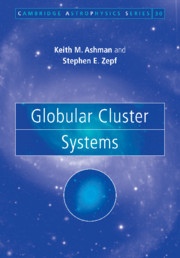Book contents
- Frontmatter
- Contents
- Preface
- 1 Introduction
- 2 Properties of globular clusters
- 3 The Galactic globular cluster system
- 4 Globular cluster systems in nearby galaxies
- 5 Properties of extragalactic globular cluster systems
- 6 Globular clusters and galaxy formation
- 7 The formation of globular clusters
- 8 Future prospects
- Appendix
- References
- Subject index
- Object index
6 - Globular clusters and galaxy formation
Published online by Cambridge University Press: 21 September 2009
- Frontmatter
- Contents
- Preface
- 1 Introduction
- 2 Properties of globular clusters
- 3 The Galactic globular cluster system
- 4 Globular cluster systems in nearby galaxies
- 5 Properties of extragalactic globular cluster systems
- 6 Globular clusters and galaxy formation
- 7 The formation of globular clusters
- 8 Future prospects
- Appendix
- References
- Subject index
- Object index
Summary
The study of globular cluster systems (GCSs) has long been motivated, at least in part, by the idea that these systems can be used as fossil records of the formation history of their host galaxies (e.g. Harris and Racine 1979; Harris 1991). As described in the previous chapter, empirical information concerning GCSs has grown tremendously in both quantity and quality in recent years. This growth has led to more discriminating tests of models of the formation and evolution of galaxies through the properties of their globular cluster systems. Understanding galaxy formation and evolution is one of the primary challenges in extragalactic astronomy and cosmology. In this chapter, we describe models of galaxy formation and the constraints placed on these models by observations of globular cluster systems.
Models of galaxy formation
Galaxy properties
In the search for a physical model of galaxy formation and evolution, one of the primary questions is why galaxies have such a wide variety of morphologies, star formation histories, and stellar kinematics. One specific issue of great interest is why some galaxies are ellipticals which have old stellar populations, are dynamically hot, and follow de Vaucouleurs' surface brightness profiles (see Section 5.2), and others spirals which have been forming stars at roughly a constant rate over a Hubble time in a rotationally supported, exponential disk.
The dynamical differences between ellipticals and spirals are interesting, particularly since these galaxies have roughly similar mass densities.
- Type
- Chapter
- Information
- Globular Cluster Systems , pp. 109 - 123Publisher: Cambridge University PressPrint publication year: 1998



